¿Por qué registrarse al instante AHORA?
-
¡ES GRATIS Y SIN COMPROMISO!
¡No tienes nada que perder y mucho que ganar! NUNCA hay obligación alguna y NO SE REQUIERE TARJETA DE CRÉDITO. -
¡ACCESO COMPLETO A LOS PERFILES Y CARACTERÍSTICAS DE LAS MUJERES!
Tendrás acceso completo y GRATUITO a toda la información del perfil de las mujeres, incluidas todas las fotos disponibles y otras funciones mejoradas para ayudarte a explorar tus oportunidades. -
¡COMIENCE A RECIBIR CARTAS DE MUJERES!
Nuestros Matchmakers locales, reales y en vivo se ponen a trabajar para usted de inmediato, SIN COSTO, haciendo coincidir su perfil con mujeres potenciales en su ciudad o región! La mayoría de los hombres empiezan a recibir cartas de mujeres cualificadas en uno o dos días, a veces incluso en unas pocas horas. -
¡OPORTUNIDAD DE VER VIDEOS DE MUJERES!
¡Tendrá la oportunidad de ver los videos de perfiles de mujeres (si están disponibles) producidos por nuestro personal local y que se encuentran exclusivamente aquí! -
¡TÚ TIENES EL CONTROL!
TÚ tienes el control. TÚ eliges quién, cómo y SI quieres comunicarte con una mujer. ¡NUNCA ninguna obligación! -
SERVICIO AL CLIENTE INIGUALABLE
¿Preguntas? ¿Preocupaciones? ¡Te invitamos a llamarnos o contactarnos en cualquier momento! Nuestra información de contacto se encuentra en la parte inferior de casi todas las páginas.
Crea tu Inicio de Sesión Aquí
Al hacer clic arriba, reconoce que ha leído y acepta nuestros términos y condiciones y política de privacidad.
¿Ya eres Usuario? Iniciar Sesión aquí.

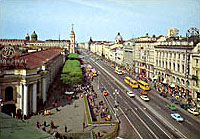 The Nevskiy Prospekt is the main thoroughfare of St. Petersburg that starts from the Admiralty Prospekt and ends at the Alexander Nevsky Square. It is 4.5 km long and 25 - 60 meters wide. The part between the Square of Insurrection and the Alexander Nevsky Square is traditionally called Old Nevsky Prospekt.
The Nevskiy Prospekt is the main thoroughfare of St. Petersburg that starts from the Admiralty Prospekt and ends at the Alexander Nevsky Square. It is 4.5 km long and 25 - 60 meters wide. The part between the Square of Insurrection and the Alexander Nevsky Square is traditionally called Old Nevsky Prospekt.
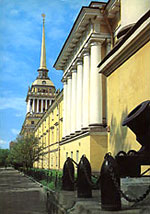
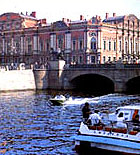 The Anichkov Palace is one of the oldest on the street. It was built in 1740 to the order of Elizabeth for one of her favorites - Count Razumovsky, then changed hands many times but belonged to the Romanov's. Now it belongs to the secondary school children. There are various amateur societies after school classes which are free of charge.
The Anichkov Palace is one of the oldest on the street. It was built in 1740 to the order of Elizabeth for one of her favorites - Count Razumovsky, then changed hands many times but belonged to the Romanov's. Now it belongs to the secondary school children. There are various amateur societies after school classes which are free of charge.
 The Alexandrinsky Theatre is the oldest professional theatre of Russia that dates from 1756. The building was constructed to the design of K. Rossi in 1832. It was one of the architectural masterpieces among theatre houses of the 19th century. The theatre and the short street (which bears the architect's name - Rossi) owes part of its beauty to this architect.
The Alexandrinsky Theatre is the oldest professional theatre of Russia that dates from 1756. The building was constructed to the design of K. Rossi in 1832. It was one of the architectural masterpieces among theatre houses of the 19th century. The theatre and the short street (which bears the architect's name - Rossi) owes part of its beauty to this architect.
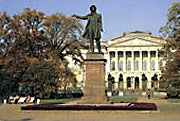 It is called so because there are 3 theatres and 2 museums located in the square. The state Philharmonic is the oldest in the country. Its symphony orchestra enjoys world fame. The building is the former Assembly Hall for Russian nobility. Musical comedy theatre was one of the three theatres, which were opened during the siege.
It is called so because there are 3 theatres and 2 museums located in the square. The state Philharmonic is the oldest in the country. Its symphony orchestra enjoys world fame. The building is the former Assembly Hall for Russian nobility. Musical comedy theatre was one of the three theatres, which were opened during the siege.
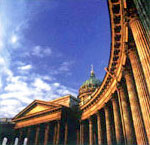
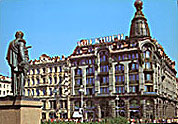 The Aeroflot booking office was built in 1912. It is a replica of the Palace of the Doges in Venice. The original tenant was a bank, now it houses the Russian Airlines agency and a few shops. The Palace bridge was built in 1916. It is a drawbridge and its bridge is lifted every night.
The Aeroflot booking office was built in 1912. It is a replica of the Palace of the Doges in Venice. The original tenant was a bank, now it houses the Russian Airlines agency and a few shops. The Palace bridge was built in 1916. It is a drawbridge and its bridge is lifted every night.